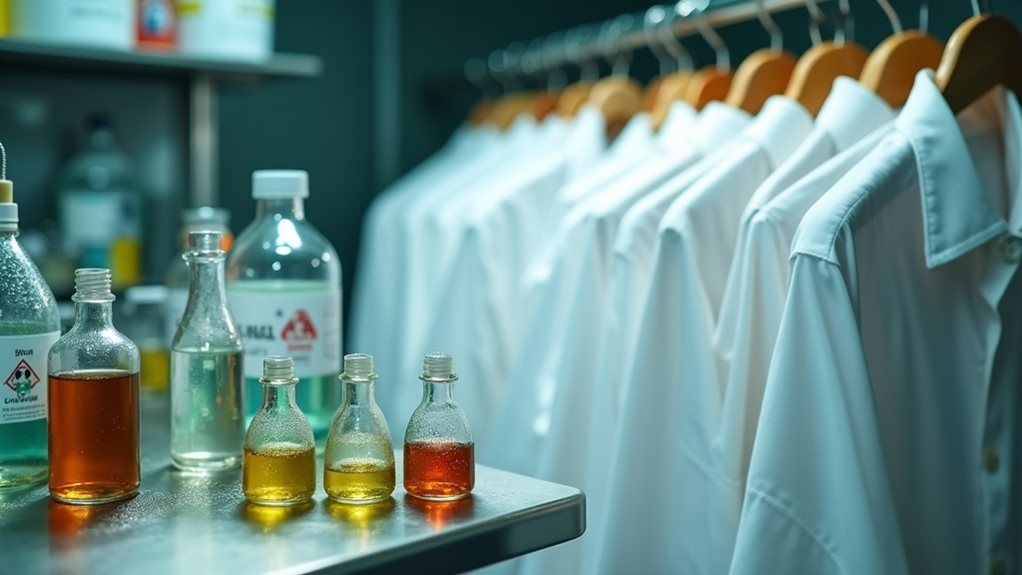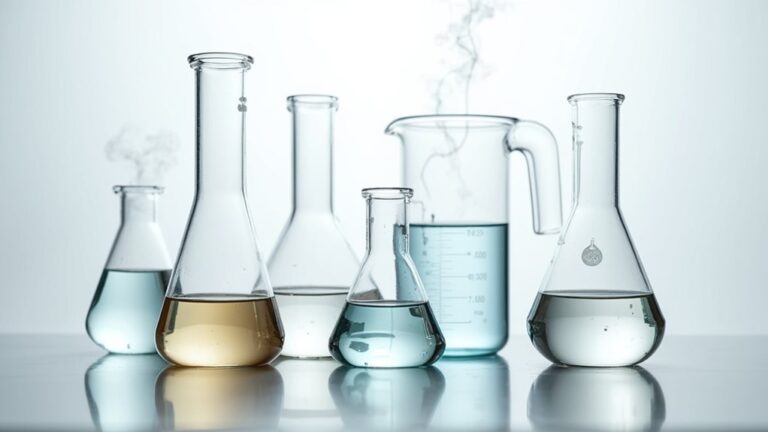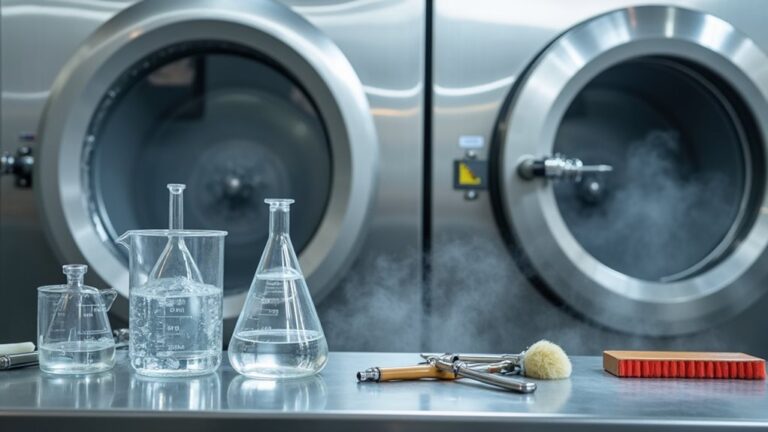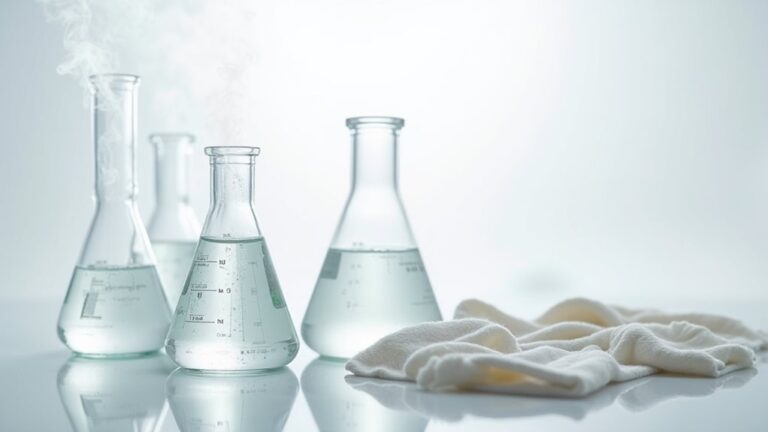Dry cleaned clothes can contain toxic residues from perchloroethylene (PERC), a recognized human carcinogen used in traditional dry cleaning processes. These chemical residues remain embedded in fabric fibers and continue releasing vapors into your home’s air, potentially causing headaches, dizziness, and long-term health risks with prolonged exposure. While occasional exposure poses relatively low risk, you can minimize toxicity by choosing eco-friendly cleaners using safer solvents or exploring at-home alternatives for many garments requiring specialized care.
Understanding Dry Cleaning Chemicals and Solvents
When you drop off your favorite suit or dress at the dry cleaner, you’re likely unaware that the cleaning process involves powerful chemical solvents that can pose considerable health risks.
Traditional dry cleaning relies heavily on perchloroethylene, commonly known as PCE, which the U.S. National Toxicology Program has classified as a human carcinogen.
The chemical perchloroethylene used in most dry cleaning facilities is officially recognized as a cancer-causing substance by federal health authorities.
These toxic chemicals don’t simply disappear after cleaning—residual perc can remain embedded in fabric fibers, creating ongoing exposure concerns.
The dry cleaning chemicals used in conventional processes also create notable environmental impact, affecting both workers and surrounding communities.
While the EPA has announced plans to phase out PCE, many cleaners still use these harmful solvents.
Beyond cancer risks, PERC exposure can cause neurological symptoms and respiratory irritation, particularly affecting dry cleaning workers who face prolonged exposure to these dangerous fumes.
Fortunately, safer alternatives are emerging, offering consumers healthier options for garment care.
Health Risks of Perchloroethylene (PERC) Exposure

Among the most concerning chemicals found in traditional dry cleaning, perchloroethylene stands out as a particularly dangerous threat to human health. This toxic solvent, classified as a human carcinogen by environmental agencies, poses serious health effects through various exposure pathways.
When you wear dry-cleaned garments, residual PERC chemicals can vaporize from fabrics, contaminating your indoor air and potentially affecting your wellbeing.
The health risks from PERC exposure include:
- Cancer development – linked to liver, kidney, brain, and testicular cancers from long-term exposure
- Neurological symptoms – dizziness, headaches, and cognitive impairments from short-term contact
- Fabric retention – notable chemical residues remain on wool, cotton, and polyester materials
- Indoor air contamination – vaporization creates ongoing exposure risks in homes and offices
While workers in dry cleaning facilities face the highest exposure levels due to prolonged contact with PERC solvents, consumers experience relatively low-risk exposure from occasional use of dry cleaned garments.
Environmental Impact of Traditional Dry Cleaning Methods

While PERC threatens individual health through direct exposure, traditional dry cleaning methods create far-reaching environmental consequences that extend well beyond the confines of cleaning facilities.
The environmental impact becomes evident when PERC escapes through ventilation systems, contributing to persistent air pollution that can linger for weeks in your community.
You’re also affected by ground contamination when these toxic solvents leak from facilities or face improper disposal, threatening local ecosystems and drinking water sources.
The long-term persistence of PERC in the environment amplifies these health issues, creating ongoing risks for both wildlife and human populations.
Additionally, the energy-intensive nature of traditional dry cleaning processes contributes significantly to carbon emissions, further exacerbating climate change concerns.
This widespread contamination underscores why you should seek safer alternatives to conventional dry cleaning methods that rely on these harmful chemicals.
N-Propyl Bromide and Other Chemical Alternatives
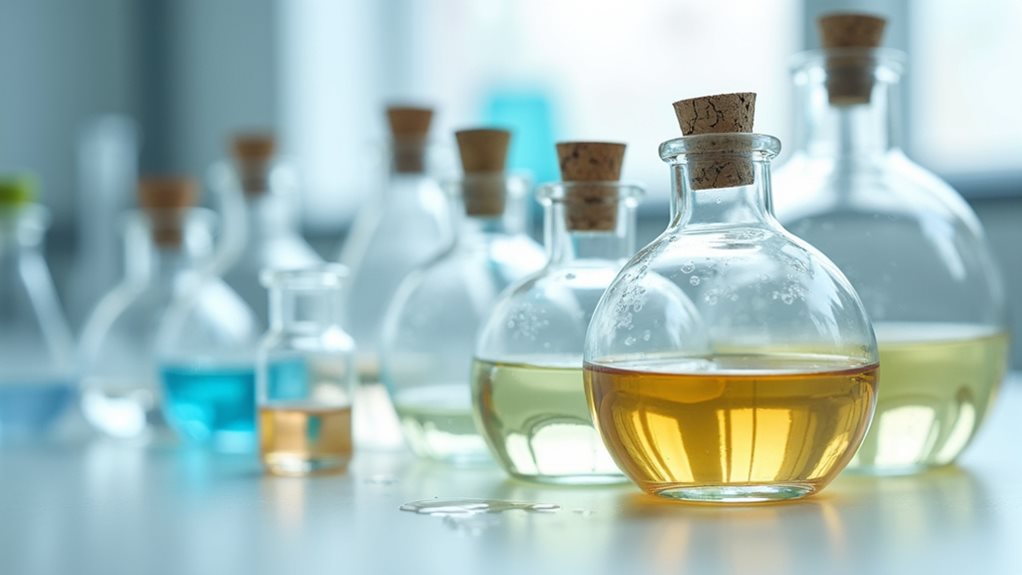
The dry cleaning industry’s response to PERC’s documented dangers has led many facilities to adopt N-Propyl Bromide as a seemingly safer alternative.
Yet this substitute chemical presents its own concerning health and environmental risks. Acute exposure causes dizziness and nausea, while chronic exposure threatens reproductive health and potentially increases cancer risks. Like PERC, N-Propyl Bromide contaminates air, soil, and waterways, persisting in marine ecosystems.
Fortunately, you can choose eco-friendly solvents that eliminate these toxic chemicals entirely:
- GreenEarth Cleaning uses liquid silicone that’s non-toxic and biodegradable
- Liquid CO2 cleaning leaves no harmful residues on fabrics
- Siloxane D5 provides effective alternatives to perc without environmental persistence
- Biodegradable detergents offer gentle care for dry-clean-only clothing
Always inquire about cleaning methods before entrusting your garments to any facility. For consumers, the health risk from chemical exposure remains relatively low when garments are properly aired out before wearing.
How Toxic Residues Remain on Your Clothing

Even after you collect your freshly cleaned garments from the dry cleaner, dangerous chemical residues don’t simply disappear from the fabric fibers.
Perchloroethylene (PERC), a known human carcinogen, embeds deeply within materials like wool, cotton, and polyester during cleaning processes.
Georgetown University research reveals that these toxic residues actually increase with repeated dry cleaning cycles, creating cumulative health risks for you as the wearer.
Your clothing becomes a reservoir for cleaning solvents, slowly releasing PERC vapors into your home environment.
This ongoing evaporation contributes to environmental pollution while exposing you to harmful chemicals through both skin contact and inhalation.
The EPA confirms that standard dry cleaning methods can’t completely eliminate these residues, meaning you’re potentially carrying toxic substances against your body every time you wear professionally cleaned garments.
Beyond cancer risks, prolonged exposure to these chemical residues has been linked to neurological problems, liver damage, and reproductive issues that can affect your long-term health.
Safer Eco-Friendly Dry Cleaning Solutions

Fortunately, you don’t have to accept toxic chemical exposure as an inevitable part of maintaining your professional wardrobe.
Green dry cleaning services now offer eco-friendly alternatives that protect both your health and the environment. These innovative methods use non-toxic solvents like liquid silicone (D5), which effectively cleans your garments without leaving harmful chemical residues on your clothing.
Eco-friendly dry cleaning uses non-toxic solvents like liquid silicone to protect your health while effectively cleaning garments without harmful residues.
Modern eco-friendly dry cleaning provides several advantages:
- Biodegradable solvents that reduce water pollution and environmental damage
- Improved garment quality through gentle cleaning processes that prevent color bleeding
- Safer wear for you and your family by eliminating toxic chemical exposure
- Convenient services including free delivery and mail-order options
Another promising eco-friendly option is liquid carbon dioxide cleaning, which uses pressurized CO2 to effectively remove stains while being completely non-toxic and environmentally safe.
When Professional Cleaning Is Actually Necessary

While eco-friendly alternatives make professional cleaning safer, certain garments genuinely require specialized care that you can’t replicate at home.
Items labeled “dry clean only,” particularly delicate fabrics like silk and wool, need professional cleaning to maintain their integrity. Garments with embellishments, glued beads, or intricate designs risk damage from water and agitation during home washing.
Professional cleaning becomes crucial for stubborn oil and grease stains that household stain remover can’t handle effectively. The specialized cleaning solvent used by professionals penetrates deep-set soiling better than conventional methods.
Dry cleaning services also play an important role in supporting essential workers like healthcare professionals and first responders who require clean uniforms to perform their duties safely and effectively.
When choosing professional services, seek eco-friendly cleaners that avoid chemical solvents with high levels of cancer-causing chemicals. Always follow care label instructions, as ignoring professional cleaning requirements can permanently damage expensive garments and void warranties.
At-Home Alternatives to Traditional Dry Cleaning

Before you automatically head to the dry cleaner, you’ll discover that many garments tagged as “dry clean only” can actually be cleaned safely at home using the right techniques and products.
These at-home alternatives provide environmentally friendly solutions that eliminate exposure to harsh chemicals while maintaining your delicate garments’ quality.
Consider these effective methods for wet cleaning at home:
- Hand wash using cold water and gentle detergent specifically designed for delicate fabrics
- Use the Dryel At-Home Dry Cleaner Kit for 20-minute garment rejuvenation with stain-removal tools
- Steam delicate items with handheld steamers like OGHom or SALAV models to remove wrinkles and odors
- Protect fragile pieces in laundry bags during machine washing cycles
These safe alternative approaches to traditional dry cleaning methods help you avoid toxic chemical exposure while achieving excellent results.
Always test any cleaning method on an inconspicuous area first to ensure the fabric care labels and material can withstand your chosen technique without damage.

